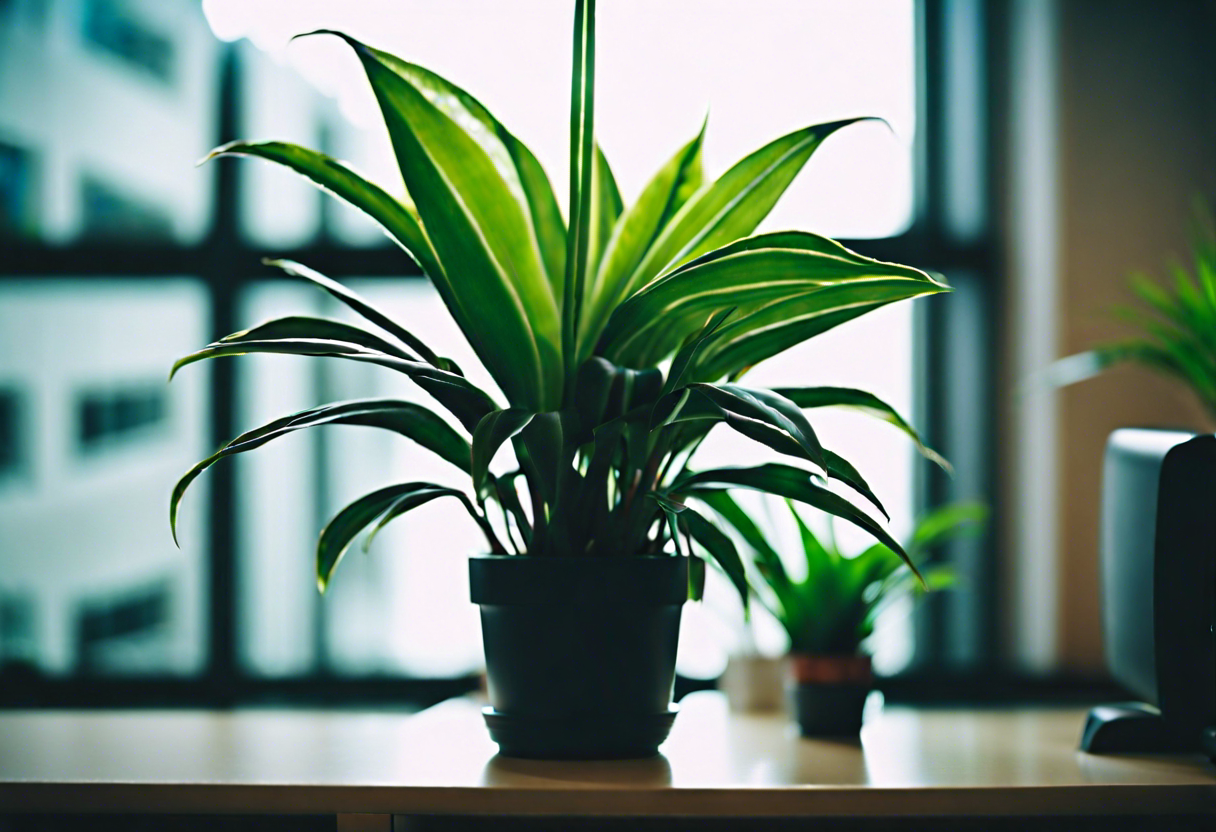Benefits of Low-Maintenance Indoor Plants in Office Spaces
For many office environments, incorporating low-maintenance indoor plants can bring numerous benefits. Not only do these plants enhance the aesthetics of the workspace, but they also have a positive impact on the overall well-being and productivity of employees.
One key advantage of low-maintenance indoor plants is their ability to purify the air by removing toxins and releasing oxygen. Research has shown that certain plants, such as snake plants, spider plants, and pothos, can effectively reduce indoor air pollutants, creating a healthier work environment. These plants act as natural air filters, absorbing harmful chemicals commonly found in office spaces, such as formaldehyde and benzene.
In addition to improving air quality, low-maintenance indoor plants also contribute to a sense of calm and relaxation. Offices can often be stressful environments, but the presence of greenery can help create a more soothing atmosphere. Research has indicated that exposure to nature, even in the form of indoor plants, can reduce stress levels and enhance overall well-being. This can lead to improved concentration, increased creativity, and a higher level of job satisfaction among employees.
Furthermore, low-maintenance indoor plants can serve as natural sound absorbers, reducing background noise and creating a more peaceful work environment. This can help minimize distractions and improve focus, allowing employees to be more productive and efficient in their tasks. Plants with broad leaves, such as the peace lily and rubber plant, are particularly effective in absorbing sound waves.
Another advantage of these plants is their ability to increase humidity levels in dry office spaces. The air conditioning and heating systems commonly found in offices can often lead to low indoor humidity, which can negatively impact respiratory health and cause dry skin. By releasing moisture through transpiration, low-maintenance indoor plants can help maintain a more comfortable and healthier humidity level in the workplace.
Incorporating low-maintenance indoor plants in office spaces can provide a range of benefits, including improved air quality, reduced stress levels, increased productivity, and enhanced well-being. Whether it’s through air purification, noise reduction, or humidity regulation, these plants contribute to a more pleasant and conducive work environment. Consider incorporating low-maintenance indoor plants into your office design to reap these advantages and create a healthier workspace for your employees.
Benefits of Low-Maintenance Indoor Plants for Office Settings
Top Low-Maintenance Indoor Plants for Office Settings
When it comes to office design, incorporating low-maintenance indoor plants can have numerous benefits. Not only do these plants add a touch of greenery and beauty to the workspace, but they also improve air quality, reduce stress levels, and increase productivity. However, choosing the right low-maintenance indoor plants for your office is crucial to ensure they thrive in the indoor environment. Here, we will discuss some of the top low-maintenance indoor plants that are well-suited for office settings.
-
Snake Plant (Sansevieria Trifasciata): Also known as "mother-in-law’s tongue," snake plants are highly resilient and can tolerate low light conditions. They are perfect for offices with minimal natural light. Snake plants have striking upright leaves that come in different varieties, making them visually appealing while requiring minimal care.
-
ZZ Plant (Zamioculcas Zamiifolia): The ZZ plant is renowned for its ability to thrive in low-light environments and tolerate irregular watering. Its glossy, dark green leaves can add a touch of elegance to any office space. ZZ plants are known for their air-purifying qualities, making them an excellent choice for improving indoor air quality.
-
Pothos (Epipremnum Aureum): Pothos is a trailing vine that is highly adaptable and can tolerate various light conditions. It is a popular choice for offices due to its low maintenance requirements and attractive heart-shaped leaves. Pothos can be displayed in hanging baskets or placed on shelves, adding a touch of lush greenery to the office environment.
-
Peace Lily (Spathiphyllum): Peace lilies are elegant plants that not only enhance the aesthetics of an office but also have air-purifying qualities. They prefer medium to low light conditions and thrive well in average room temperatures. Peace lilies also produce beautiful white flowers, adding a serene touch to the workspace.
-
Chinese Evergreen (Aglaonema): Chinese evergreen is a versatile plant that comes in various colors and patterns. It thrives in low to medium light conditions and can tolerate neglect, making it an ideal choice for busy offices. Chinese evergreen removes toxins from the air, contributing to a healthier work environment.
-
Spider Plant (Chlorophytum Comosum): Spider plants are known for their cascading, arching leaves, which can instantly brighten up any office space. They are easy to care for and can thrive in a wide range of light conditions. Spider plants also have air-purifying qualities, making them beneficial for indoor environments.
Remember that while these low-maintenance indoor plants are hardy, they still require some care to ensure their well-being. Basic care includes providing adequate light, watering appropriately, and occasionally fertilizing. Consult plant care guides or reach out to local experts for specific care instructions based on the plant varieties you choose.
By incorporating these top low-maintenance indoor plants into your office design, you can create a more inviting and visually appealing workspace while enjoying the numerous benefits they offer. Whether you have a well-lit office or a space with limited natural light, there is a low-maintenance indoor plant suitable for every office setting.
Tips for Caring for Low-Maintenance Indoor Plants in the Office
Taking care of low-maintenance indoor plants in the office does not have to be a daunting task. With a few simple tips and tricks, you can ensure that your office plants thrive and add a touch of greenery to your workspace. Here are some guidelines to help you care for your low-maintenance indoor plants effectively:
-
Choose the right plants: When selecting low-maintenance indoor plants for your office, opt for varieties that can thrive in typical office conditions. These plants should be able to withstand low light, inconsistent watering, and temperature fluctuations. Some popular options include pothos, snake plants, ZZ plants, and peace lilies.
-
Find the right spot: Place your plants near a window where they can receive indirect sunlight. If your office has limited natural light, consider using artificial grow lights to provide the necessary light for your plants’ growth. Avoid placing plants in direct sunlight, as it can cause leaf burn.
-
Water sparingly: Low-maintenance indoor plants generally don’t require frequent watering. Overwatering is one of the most common mistakes people make, which can lead to root rot and the death of the plant. Before watering, always check the soil moisture level by inserting your finger into the soil. If it feels dry up to the first inch, it’s time to water. Be sure to use well-draining pots to prevent waterlogged roots.
-
Establish a watering schedule: To avoid overwatering or underwatering, establish a watering schedule based on the specific needs of each plant. Some plants may require watering once a week, while others may only need to be watered every two weeks. Monitor the soil moisture level regularly and adjust the watering frequency accordingly.
-
Provide adequate humidity: Office environments can be dry, especially during the winter months when heaters are running. Low humidity levels can lead to dry and browning leaves. Increase humidity around your plants by misting them with water or placing a tray of water near the plants. Alternatively, consider using a humidifier to maintain the ideal humidity level for your plants.
-
Dust the leaves: Dust can accumulate on the leaves of indoor plants, hindering their ability to absorb sunlight. Regularly wipe the leaves with a soft damp cloth or gently spray them with water to keep them clean and free from dust. This will help your plants stay healthy and vibrant.
-
Monitor for pests: Although low-maintenance plants are generally more resilient against pests, it’s essential to keep an eye out for any signs of infestation. Common pests that can affect indoor plants include spider mites, mealybugs, and fungus gnats. If you notice any pests, take immediate action to control the infestation and prevent it from spreading to other plants.
By following these tips, you can ensure that your low-maintenance indoor plants thrive in your office space. Remember to observe your plants closely and make adjustments to their care routine as needed. With a little effort, you can enjoy the beauty and benefits that office plants bring to your workspace.
Choose the right low-maintenance indoor plants for your office
When it comes to selecting the perfect low-maintenance indoor plants for your office, there are several factors to consider. Not only do you want to choose plants that require minimal care and attention, but you also want them to thrive in the indoor environment of your workspace. Here are some helpful tips to guide you in selecting the right plants for your office:
Consider the lighting conditions
One of the most important factors to consider when choosing low-maintenance indoor plants for your office is the lighting conditions. Most office spaces have limited natural light, so it is crucial to choose plants that can thrive in low-light or indirect light conditions. Some excellent options for low-light conditions include snake plants, ZZ plants, and pothos.
Assess the space availability
Another consideration is the available space in your office. If you have limited floor space, you may want to consider plants that can be placed on desks or shelves. Succulents, such as aloe vera and jade plants, are perfect for small spaces due to their compact size and ability to store water, making them less demanding in terms of watering frequency.
Take into account maintenance requirements
Choosing low-maintenance indoor plants means selecting plants that require minimal care and attention. Look for plants that do not need frequent watering or pruning. Some examples of low-maintenance plants include the peace lily, spider plant, and the Chinese evergreen. These plants are known for their ability to thrive in various indoor conditions with minimal care.
Consider the air quality benefits
In addition to enhancing the aesthetics of your office, low-maintenance indoor plants can also improve the air quality. Certain plants, such as the snake plant and the spider plant, are known for their air-purifying properties. These plants can help to remove toxins from the air, making the office environment healthier and more pleasant.
Think about the overall aesthetic
consider the overall aesthetic of your office when selecting low-maintenance indoor plants. Choose plants that complement the interior design and create a soothing and welcoming atmosphere. Plants with vibrant green foliage, such as the pothos or the fiddle-leaf fig, can add a touch of freshness and vitality to your workspace.
By considering factors such as lighting conditions, space availability, maintenance requirements, air quality benefits, and overall aesthetic, you can choose the right low-maintenance indoor plants for your office. These plants will not only require minimal care but also contribute to a healthier and more productive work environment.
Best Practices for Office Design with Low-Maintenance Indoor Plants
Introduction
Creating a pleasant and inviting work environment is essential for boosting employee morale and productivity. One effective way to achieve this is by incorporating low-maintenance indoor plants into office design. These plants not only enhance the aesthetic appeal but also offer numerous benefits, such as improved air quality and reduced stress levels. In this article, we will explore some of the best practices for incorporating low-maintenance indoor plants into office design.
Choosing the Right Plants
When selecting low-maintenance indoor plants for your office, it’s important to consider factors such as lighting conditions and space availability. Opt for plants that can thrive in low light environments, as most office spaces have limited access to natural sunlight. Some popular choices include snake plants, ZZ plants, and pothos, which can tolerate low light conditions and require minimal care.
Placement and Arrangement
Strategic placement and arrangement of indoor plants can make a significant impact on the overall office design. Consider placing plants near windows or areas where they can receive adequate sunlight. This not only ensures their proper growth but also adds a touch of nature to the workspace. Additionally, clustering plants together in groups or using planters as dividers can help create visually appealing green zones within the office.
Maintenance and Care
One of the key benefits of low-maintenance indoor plants is their ability to thrive with minimal care. However, it’s essential to provide basic maintenance to ensure their longevity. Regular watering, dusting of leaves, and occasional fertilization are some simple practices that can keep your office plants healthy. It’s also recommended to rotate plants periodically, allowing all sides to receive equal light exposure.
Variety and Diversity
Introducing a variety of plant species into your office space not only adds visual interest but also provides a conducive environment for improved air quality. Different plants have varying abilities to remove toxins from the air, so incorporating a mix of plants will enhance their overall effectiveness. Some excellent choices for air-purifying low-maintenance plants include peace lilies, spider plants, and Chinese evergreens.
Green Spaces
Apart from individual potted plants, consider creating green spaces within the office design. Living walls or vertical gardens can be eye-catching focal points that enhance the overall aesthetic appeal. These green installations not only add beauty but also contribute to a healthier and more productive work environment.
The incorporation of low-maintenance indoor plants into office design brings life and vitality to any workspace. By carefully selecting the right plants, strategically arranging them, providing basic care, and introducing a variety of species, you can create a thriving haven of greenery within your office. Keep these best practices in mind, and watch as your employees enjoy the numerous benefits that come with working amidst nature.
Conclusion
Low-maintenance indoor plants into office spaces offers a wide range of benefits. Not only do these plants enhance the aesthetics of the workplace, but they also promote a healthy and productive environment for employees. By reducing stress levels, improving air quality, and increasing concentration, these plants have proven to be valuable assets in the office setting.
When it comes to choosing the best low-maintenance indoor plants for your office, there are several options to consider. Succulents, such as aloe vera and jade plants, are excellent choices as they require minimal care and can thrive with little sunlight. Spider plants are another popular option, known for their adaptability and ability to purify the air. ZZ plants and pothos are also great choices, as they can withstand low-light conditions and irregular watering.
To ensure the well-being of your low-maintenance indoor plants, it is essential to provide them with the proper care. While these plants may not require frequent watering, it is important to check the soil regularly and water accordingly. Avoid overwatering, as this can lead to root rot. Additionally, it is advisable to clean the leaves of your plants periodically to remove dust and improve their ability to absorb sunlight.
Choosing the right low-maintenance indoor plants for your office involves considering factors such as lighting conditions and available space. Assess the amount of natural light your office receives and select plants that can thrive in those conditions. If your office has limited sunlight, opt for plants that are known for their ability to tolerate low-light environments. Additionally, consider the size and versatility of the plants to ensure they fit well within the available space.
Low-maintenance indoor plants into office design requires careful thought and consideration. To maximize the benefits of these plants, it is important to strategically place them throughout the office. Consider placing larger plants near workstations or in common areas to improve air quality and create a more inviting atmosphere. Smaller plants can be used to add accents to desks or shelves, enhancing the overall aesthetic appeal of the office.
Low-maintenance indoor plants offer numerous benefits in the office setting. From reducing stress levels to improving air quality and increasing employee productivity, these plants are a valuable addition to any workplace. By following the tips for caring and choosing the right plants, offices can create a healthier and more vibrant environment. these plants into office design can significantly enhance the overall look and feel of the workspace, creating a positive and inviting atmosphere for employees. So, why not bring some greenery into your office and reap the benefits of low-maintenance indoor plants today?


